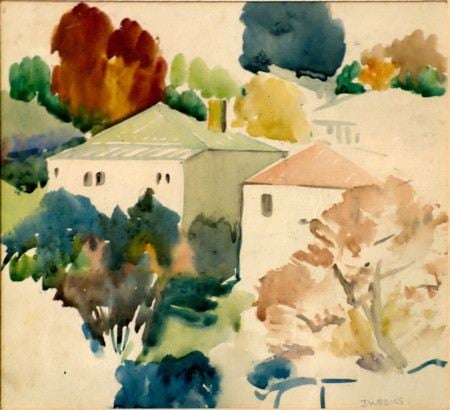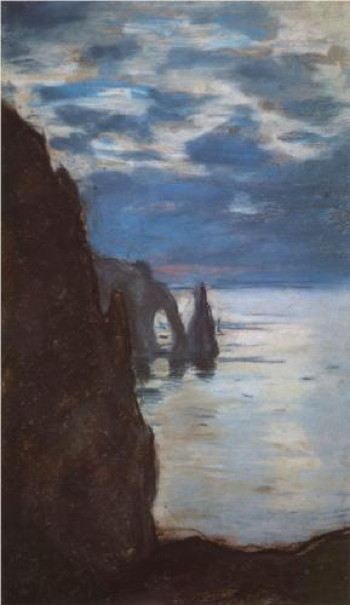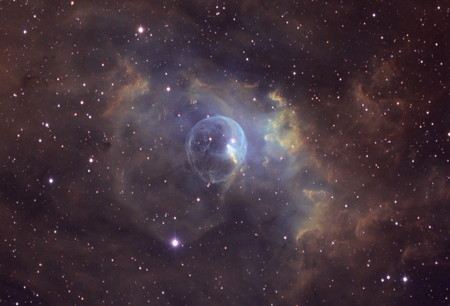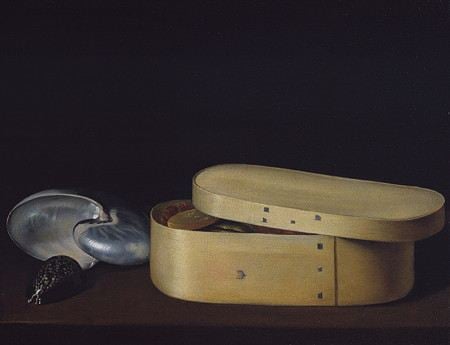“Ah, vous dirai-je, Maman”
Andre Previn
“All Through the Night
Stuart Duncan, Edgar Meyer, Chris Thile, Aoife O’Donovan & Yo-Yo Ma
“Mr. Tambourine Man
Bob Dylan
On Wonder
Photograph of a watercolour sketch
John Weeks done while teaching at Elam Art School around 1950
http://en.wikipedia.org/wiki/File:Watercolour_sketch_by_John_Weeks,_circa_1950.jpg
We Want to Be Beguiled. That is, in one sense, what “wonder” is about. That which provokes a sense of wonder in us, beguiles us, that is, not to say that everything that beguiles is wonderful, but if we are not beguiled we are probably not in the presence of wonder. It might also be said that the more wonderful something it is, the longer it continues to beguile us, it may be that this is the difference between the wonderful and the fanciful. That which is merely fanciful beguiles us for the time it takes us to become accustomed to it, but the more accustomed we become with the truly wonderful the more it continues to beguile. Often wonder is provoked by simplicity, as is the case with the first two songs in the audio clip, they are children’s songs; they are lullabies. When Mozart composed his piano concerto, the melody we know as “Twinkle, Twinkle, Little Star” was already a popular song in the nursery. He composed his variations around this simple melody and it beguiles, perhaps not to the extent that the Jupiter Symphony beguiles us, but it is beguiling. The same is true of the lullaby “All Through the Night.” Though the melody itself is quite simple, it has a sophistication that keeps it from sounding out of place on the cello, the richness of the music is complemented by the richness of the cello’s sound.
John Weeks’ watercolor sketch is also a simple sketch, probably done quickly, that captivates the viewer with its simplicity, the simplicity of the lines and the simplicity of the colors and their placement. The drawing captures the outlines of a space and evokes enough of the reality of that space for the viewer to be able to fill in the missing details. Part of the wonder that is provoked by that which is successfully and simply done lies in the artist’s ability to evoke much with very little. There is something magic about it. The Bob Dylan song is a list, almost Whitman-esque of various images that provoke wonder, the sound of a tambourine, the sound of a singer, the night passing into the morning twilight. The music is also fairly simple, folk blues played on a guitar. And though not everyone finds Dylan’s voice sublime, I do, as do many others.
Still Life with a Skull and a Writing Quill, 1628
Pieter Claesz (Dutch, 1596/97–1660)
Oil on wood
9 1/2 x 14 1/8 in. (24.1 x 35.9 cm)
Rogers Fund, 1949 (49.107)
http://www.metmuseum.org/toah/works-of-art/49.107
There was a debate that took place recently in The New Republic between Steven Pinker and Leon Wieseltier (“Science Is Not Your Enemy”, “Crimes Against Humanities”, and “Science vs. the Humanities, Round Two”). Pinker thinks the Sciences and the Humanities should unite and work together; Wieseltier thinks they operate in different spheres and one side must give up too much of what makes it what it is for there to be unification. For both Pinker and Wieseltier wonder is an important element of their argument. Pinker sees in the Sciences and the new technologies that which is truly wonderful and awe inspiring. Wieseltier agrees that there is much in science that is wonderful and awe inspiring. But the wonder and the awe proceed from different sources. Wieseltier argues that what science tries to do when it applies its methods to the humanities is identify where the magic is found. But for those that approach the arts from within the humanities it is this “magic” that they find attractive and that it is not so much that the sciences in explaining the magic destroy the magic but that the scientist fails to understand the magic the humanist finds in the arts. It does not lie in the mixture of colors and textures, in the sounds and evocations of language, in the combination of notes in a piece of music. Of course that is where the magic lives, but the scientific explanation of how the magic works reveals a misunderstanding of the magic itself. I wonder, though, how an understanding of the science in Claesz’s Still Life with a Skull and a Writing Quill would explain its sublime qualities or ease the discomfort it provokes. D. H. Lawrence’s poem “The Third Thing” illustrates the problem the scientist encounters when examining the arts:
Water is H2O, hydrogen two parts, oxygen one,
but there is also a third thing, that makes it water
and nobody knows what it is.
The atom locks up two energies
but it is a third thing present which makes it an atom.
The sciences are only capable of exploring the two parts of the atom, but they cannot explore that third thing that makes it an atom, at least not that which makes the atom “wonderful” to the humanist.
The humanities and the sciences also have a different relationship with the past. Science moves forward, the only reason for it to look backwards is to remind itself where it’s been and what, through investigation and experimentation, has been left behind. There is no need for the scientist to study the pre-Copernican universe because the scientist knows that model of the universe has been disproved. That said, the medievalist C. S. Lewis wrote a book, The Discarded Image that explains the medieval world view and its understanding of the universe. Where the science is no longer relevant the magic of its conception still beguiles the imagination of some, it beguiled Lewis’ imagination. This is not to say he wanted to return to a medieval understanding of the universe, only to say there is an elegance to its construction that is appealing. It worked for Lewis as story, he never accepted it as science, but from the perspective of the humanities, the story is important and still has something to teach us, it possess a different kind of truth. To one critic, Matthew Ward, Lewis’ study of the medieval view of the universe provided the frame upon which he built his series of children’s stories, The Chronicles of Narnia. For the scientist there is not much point in this looking backwards. This is not to say that good scientists do not keep an open mind and do not continue to test theories, even after they seem to have been proven false. But there comes of a time when the body of accumulated evidence overwhelms a model or a theory and it is abandoned. That which is affirmed is carried forward but in being carried forward it remains part of the present, it does not live in the past. The Humanities have a different relationship to the past.
Etretat, the Needle Rock and Porte d’Aval
Claude Monet
http://www.wikipaintings.org/nl/claude-monet/etretat-the-needle-rock-and-porte-d-aval
Where science looks to the past to be certain something has not been tried before and found wanting, the humanities sees the past as part of the present. They maintain a dialog of sorts between the wisdom of the past and the wisdom of the present. Humanists believe both the past and the present have something to say to each other, that each can learn from each other and contribute something to the understanding of the other. The past, of course cannot be changed, but our understanding of the past is sometimes changed by what has been learned and understood subsequently. On the other hand, the wisdom of the present is enriched by the wisdom of the past and the wisdom of each contributes to the shape and direction the present and the future take. To close our eyes to either can have detrimental effects on the world we live in and pass along to those that come after us. Math and science make us better machines; the humanities make us better human beings. This is generalization of course, not everything the sciences give us are necessarily better, some insidious machines have been put into our hands that unfortunately work too well. By the same token, not everyone that has embraced the humanities has been made better by them. History is filled with movements and individuals that had a highly refined taste in art and literature who were miserable human beings that did truly evil things.
A Super Moon’s Halo
NASA’s Astronomy Picture Of The Day – Louis Argerich
http://socksonanoctopus.com/blog/2013/06/nasas-astronomy-picture-of-the-day-a-super-moons-halo/
Perhaps the real difference between the humanities and the sciences and the wonder each provokes lies in the different way they look at and experience the universe. The photographs above and below are wonderful in both the scientific and the humanistic sense. They inspire awe. I expect these pictures also provoke awe in the humanistic sense in both scientists and humanists. Both scientists and humanists probably also experience the awe provoked by the science as well. But the scientist wants to explore the awe provoked by the science while the humanist wants to explore the awe that is provoked by the artistry of the photograph and the subject of the photograph. I do not understand how atmosphere, light, gases, and chemical reactions produced the subjects of these photographs, though I wouldn’t mind knowing. But knowing how the subjects of the pictures were produced would not explain to me or clarify for me the sense of wonder the photographs produce. I do not want to understand the science as much as I want to understand what makes them beautiful and why the beauty found in the photographs affects me the way it does.
The Bubble Nebula
NASA Picture of the Day
http://apod.nasa.gov/apod/ap100902.html
This perhaps draws attention to an old debate, to an old problem, that of materialism vs. idealism. A materialist believes, generally, that there is nothing more to the universe than that which can be perceived through the senses. Things may be there that the senses cannot perceive at present, but once the tools are invented that will enable the senses to perceive their presence the senses will perceive them. Pluto, whether it is a planet or something other, was always present even if it could not always be seen. Once telescopes powerful enough to see it were produced, Pluto could be seen. An idealist believes there is more to the universe than can be perceived through the senses. The debate is, I suppose, about the third thing in Lawrence’s poem. Is it real or imaginary? That something is something more than the Higgs-Boson particle, it is something that cannot be taken in through the senses no matter how sophisticated the tools we invent become.
Pinker, for example, views all religion as superstition because no religion can be proven through the scientific method. The “evidence” is not there. This makes religion, for Pinker the product of superstition and self-delusion. He is a materialist. Wieseltier argues that religious people, like idealists in general, construct a rational philosophy around their faith. The religious dynamic is as real to them as the scientific dynamic is to the scientist. This does not mean all humanistic thought is religious, but like religious thought, humanistic thought is concerned with more than can be materially proven. There probably is no such thing as a “pure” materialist or a “pure” idealist. Idealists still at times believe only what their senses tell them, still pursue material gain, often without regard to the ethical ramifications of those pursuits. Materialists are often “good” in the sense that they put the interests of others ahead of self-interest; do good things even when it is not in their self-interest to do good things. They are rarely like Wolf Larson, for example, in Jack London’s The Sea Wolf who takes what he wants because he is strong enough to take it. He believes in the “survival of the fittest” and believes because he is one of the fittest he is entitled to take what he wants. He is the consummate materialist.
Landscape with wheat sheaves and rising moon
Vincent van Gogh
http://en.wikipedia.org/wiki/File:Landscape_with_wheat_sheaves_and_rising_moon.jpg
The painting captures the same moon (though a few years younger) as is seen in the photograph. An understanding of the science behind a moon rise and the atmospheric conditions surrounding it will not tell us anything about why this painting is beautiful. Nor would an understanding of the principles of light and texture and color explain why this painting is wonderful. Such an investigation might help us understand how it was constructed and why certain colors in combination with one another are pleasing to the eye, but this will not unlock its wonder. Edgar Allen Poe’s poem “Sonnet to Science” addresses another aspect of the divide between science and the humanities:
SCIENCE! meet daughter of old Time thou art
Who alterest all things with thy peering eyes!
Why prey’st thou thus upon the poet’s heart,
Vulture! whose wings are dull realities!
How should he love thee – or how deem thee wise
Who woulds’t not leave him, in his wandering,
To seek for treasure in the jewell’d skies
Albeit, he soar with an undaunted wing?
Hast thou not dragg’d Diana from her car,
And driv’n the Hamadryad from the wood
To seek a shelter in some happier star!
The gentle Naiad from her fountain-flood
The elfin from the green grass? and from me
The summer dream beneath the shrubbery?
Poe’s response to Pinker would be to point out that science seeks to explain away the magic, to demonstrate why the magic is not really magic. To the scientist this poem may seem an exercise in denial. Yes, science has shown that all that Poe points out is false, that it does not in fact exist, it is myth, folklore, and superstition. It does not matter that we want the magic to be real, it isn’t and that ends it. But, to this day elves and other magical creatures appear in stories. This does not make them real, but it does say something about the desires and aspirations of the human imagination. And perhaps, in a sense these myths are real, they give an imagined body to principles and quirks of human behavior that enable us to better understand ourselves. There may be no spirits in rivers or in trees, there may be no elves or dwarfs living in the secret places of the earth, but the attitudes elves and dwarfs personify are found all around us. When we enter the worlds in which such creatures live we have to suspend our disbelief, we willingly enter these worlds knowing what we will find there is not real, in the scientific sense, but also that they point to that “third thing” that science cannot explain.
A carving of a dragon from Imperial City, Huế in Viet Nam
Anonymous
http://en.wikipedia.org/wiki/File:Roof_detail,_dragon.jpg
Steve Paulson in “Monsters, Marvels, and the Birth of Science” presents another view of science and its beginnings. One aspect of the article pursues the human fascination with monsters and their ubiquity throughout history. The Photograph above is of a dragon and, being an Asian dragon, it is probably a friendly dragon, but one never knows. Many of our oldest stories involve monsters; Odysseus and the Cyclops, Beowulf and Grendel, Sir Gawain and the Green Knight. Many of Ovid’s retellings of Roman myths in The Metamorphoses involve monsters and battles with monsters. Many of Snorri Sturluson’s retelling of Norse myths also involve encounters with monsters. They are found everywhere. I think one of the reasons space travel is such a popular vehicle for storytelling is because in the unexplored reaches of space one can expect to find anything (and one can also expect that anything waiting to be found might also pay us a visit). The monsters encountered in The Thing and Alien mean to do us harm, whereas the monsters found in ET and The Day the Earth Stood Still are more concerned with our welfare, they are at the very least motivated more by kindness than malevolence.
Avatar The Trailer
James Cameron’
20th Century Fox
The film clip captures another aspect of wonder and of the monstrous. Are the creatures of Pandora monsters that need to be subdued, like some of the other wildlife found there? Or are the more “human” colonizers the monsters or at least the more monstrous. The film captures our fascination with what we do not understand. It also speaks to some of our better “angels” in that we find ourselves siding with the “monsters,” the “savages.” In this regard the film is a study in good vs. evil. But it is not just the story that enchants us; the special effects of the movie also provoke wonder. They present us with a grand spectacle. But is it the wonderful that beguiles us in this film or the fanciful. I remember seeing 2001 a Space Odyssey when it first came out. I was enchanted and beguiled by the special effects in that movie. But when I watch it today the effects are not as spellbinding. The art of special effects has far surpassed what was so revolutionary in Kubrick’s film. Much of what appeared wonderful in the film looks merely fanciful today. It is a landmark in film history and probably in the art of filmmaking. There are other aspects of the film that hold up very well as storytelling, but if the artistic life of the film depended on its special effects would it still attract an audience today? I wonder about Avatar if this might not also be the case. The time will come when the art of special effects will far surpass the effects found in this film. As Aristotle said, spectacle is an aspect of the theater, but it is not its most important aspect and not what gives the play (or the screenplay) its longevity.
Glasses
Gilles Tran
http://en.wikipedia.org/wiki/File:Glasses_800_edit.png
Then there is the image above. It is entirely computer generated. It provokes a sense of wonder when one considers what a series of “ones and zeros” can create. It suggests the beginning, perhaps, of the holodeck, that place in the science fiction world of Star Trek where we can live out and participate in the creations of our imaginations. It might also suggest that for the scientist to fully enjoy the fruits of science they need a bit of the humanist inside them in order to imagine what to do with all those wonderful machines. But again, is this fanciful or truly beguiling? Is the wonder created by our technology a short-lived wonder or does it have a longer life? Is there a story in the image that can keep it interesting after the novelty of how it was created has worn off? Sometimes science gives us the tools while the humanities provide the inspiration for their use, where humane uses are available. Of course one must be careful here to distinguish between the humanities and effective marketing.
Sam Kean (“Science, Right and Wrong”) picks up on another aspect of Paulson’s article, science and changing attitudes towards curiosity. Both articles point out that curiosity for a very long time was seen as a vice and not a virtue. Curiosity was a paving stone on the road to hell. This seems an odd and foreign attitude today; at least it does to me today. I cannot imagine a life lived without curiosity. There is an aspect of wonder that is aligned with curiosity. Wonder stimulates our senses and our senses want answers. It is curiosity that drives the scientist to understand science and its objects of study and curiosity that drives the humanist to comprehend the humanities’ significance to human life and experience. There are times when these two responses to wonder run parallel with each other, or can at least feed each other if each is given its own path to travel.
When I look at the night sky I see something wonderfully sublime. It strikes an emotional cord inside me that has nothing to do with physics, astronomy, or the pull of gravity. It has to do with grandeur and magnificence and other things that are perhaps subjective at some level, but at another level I do not think so because so many before me have responded in the same way. For the sciences the focus is on its subjects measurability, on quantifying and defining it; for the humanities it is the subjects ineffability, that which defies measurement and quantification. Sometimes it seems the scientific response is the easier one, because it proceeds with answers to all questions or at least the belief that answers are forthcoming. For the humanist the questions are often provoked by what remains after the scientist has finished.
Still Life with a Nautilus, Panther Shell, and Chip-Wood Box, ca. 1630
Sébastien Stoskopff (Alsatian, 1597–1657)
Oil on canvas
18 1/2 x 23 3/8 in. (47 x 59.4 cm)
Wrightsman Fund, 2002 (2002.68)
http://www.metmuseum.org/toah/works-of-art/2002.68









